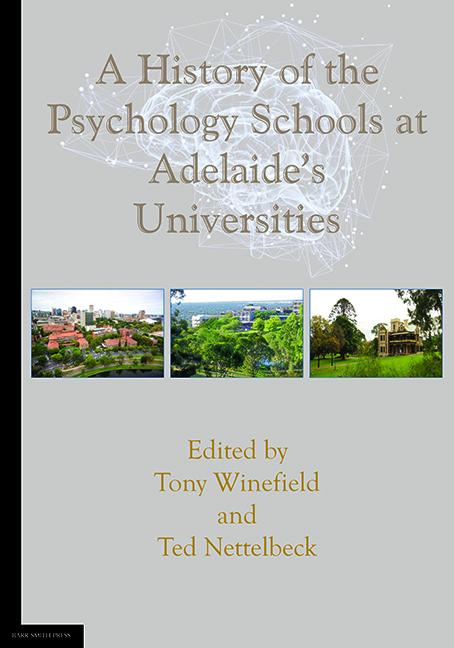Book contents
- Frontmatter
- Contents
- List of contributors
- Preface
- 1 Introduction
- 2 The origins and early history of the University of Adelaide's School of Psychology
- 3 The later years
- 4 Teaching applied psychology at the University of Adelaide: A personal view
- 5 Flinders University: Psychology in the twentieth century
- 6 Recent history of Flinders School of Psychology
- 7 The history of Psychology at the University of South Australia: From little things big things grow
- 8 The history of Psychology at the University of South Australia: Recent history
4 - Teaching applied psychology at the University of Adelaide: A personal view
Published online by Cambridge University Press: 25 July 2017
- Frontmatter
- Contents
- List of contributors
- Preface
- 1 Introduction
- 2 The origins and early history of the University of Adelaide's School of Psychology
- 3 The later years
- 4 Teaching applied psychology at the University of Adelaide: A personal view
- 5 Flinders University: Psychology in the twentieth century
- 6 Recent history of Flinders School of Psychology
- 7 The history of Psychology at the University of South Australia: From little things big things grow
- 8 The history of Psychology at the University of South Australia: Recent history
Summary
The beginning of applied psychology training in South Australia
In 1974 the introduction of the Diploma in Applied Psychology marked a major change in the teaching and research within the then Department (now School) of Psychology at the University of Adelaide. Prior to that time, the Department of Psychology had been almost entirely experimental in its approach to psychology, exemplifying the ‘rats and stats’ tag given by students to the subject. The ‘stats’ tag was to endure to the present time, but ‘rats’ ended in 1996 with the phasing out of practicals using rats in ‘Skinner boxes’, which had been organised for many years by Frank Dalziel to demonstrate operant conditioning principles.
Before 1974, the major division within the teaching of psychology in the department was not, as it is now, between theoretical and applied psychology, but between experimental and social psychology. A general first-year course was followed by Psychology 2A and then 3A, which involved topics like cognition and animal behaviour, and by Psychology 2B and then 3B, which included developmental and social psychology. In neither type of course was there any practical training in how to apply psychology within the community. The A and B streams of psychology were eventually combined into a single second- and third-year course, still without the inclusion of any training in the application of psychology. The third year in psychology was followed by an honours year, again with an experimental focus, and the honours year prepared students interested in research for a PhD in experimental psychology.
The circumstances that led to the Diploma in Applied Psychology began with what became known as the Anderson report (Anderson, 1965), after the state of Victoria set up a Board of Inquiry to investigate complaints about Scientology. The report investigated complaints concerning the practice of Scientology and, in particular, its use of what were considered by the report to be pseudo-psychological assessments using an E meter. The E meter measured galvanic skin response, but Scientologists used it to diagnose psychological conditions as part of a process designed to recruit often-unsuspecting members of the public to the practice of Scientology.
- Type
- Chapter
- Information
- Publisher: The University of Adelaide PressPrint publication year: 2016



